Mainly About Books
by the Books Editor
While the country continues to struggle with the effects of the pandemic, the outcome of which is still unclear in its development, some are turning their thoughts to thinking about what needs to be done, especially in the Dublin region where the disease has been most dangerous. Planning for the future ought to mean looking back at previous scheme to see what good things in them might be retrieved.
The other day, among my late father’s books I found an interesting document which I suspect few in this generation will have seen or heard about. (My father, I should explain, had been a consulting engineer in Dublin and latterly a professor of architecture in the US.)
Attractively designed and printed in Dublin, it is entitled Dublin Sketch Development Plan, and dates from 1939. It was issued with caveats about the possible effect of the war which had just begun, but spoke still of a need to look forward. It cost all of two shillings.
This report was the work of Prof. Patrick Abercrombie, Sydney A. Kelly and Manning Robertson. Brief as it is, it contains much that is of interest today.
In this plan from 1939, the scheme was placed in the very centre of the city, on a riverside site between Liffey Street and Capel Street. The plan provided for City Offices to be where they are today”
But of special interest to readers of this paper is its presentation of a new vision of a Catholic cathedral for Dublin.
The fact that the Church of Ireland had two cathedrals, and “we don’t have one” was long a special bugbear of some in the city. Some thought one should be ‘given back’ – but I am sure that the present administration in Drumcondra is very happy that it was never landed with a renovated edifice which would prove increasingly costly over time to maintain. They had in mind a cathedral in Merrion Square, as an expression of ecclesiastical power squarely in the centre of government power – symbolic indeed. But costs (and difficulties with the site) very soon would push that plan off the table forever.
A quarter of a century earlier, Prof. Abercrombie had drawn a plan for the city after all the reckless destruction by Republican forces and British artillery at parts of Dublin the Revolutionary years. In that he placed the long envisages cathedral on the north side of the city, to provide a major social focus point in the then most neglected part of the city.
Attractive
In this plan from 1939, the scheme was placed in the very centre of the city (see drawing above), on a riverside site between Liffey Street and Capel Street. The plan provided for City Offices to be where they are today, but opened new parks, a bus terminal and other open spaces and vistas that would have been very attractive.
Dublin looked with envy at London’s Westminster cathedral (as yet unfinished) and to Liverpool where the new Catholic cathedral was a strikingly modern affair.
Frankly, there is no likelihood that there will ever be a Catholic cathedral of that kind – the change of St Mary’s in Marlborough Street from a pro-cathedral to a full cathedral is a more likely outcome.
But in another sense the dedication of a central site to an edifice that would have been an expression of the human spirit, and would have been placed not facing the centre of government power, but placed among the pulsing daily life of the people of the city was visionary.
Every city should have such an edifice, and not the huge administrative, banking and mercantile skyscrapers we got.
While a cathedral may not eventuate, surely some thought might be given to something that expresses the value Dubliners place, not on a politically famed past, or a commercial developer’s idea of a future (to be rebuilt every decade as now), but as I say, an expression of the spiritual nature of humanity would be welcome.
Post-Covid 19 planners might like to think about it.


 Peter Costello
Peter Costello
